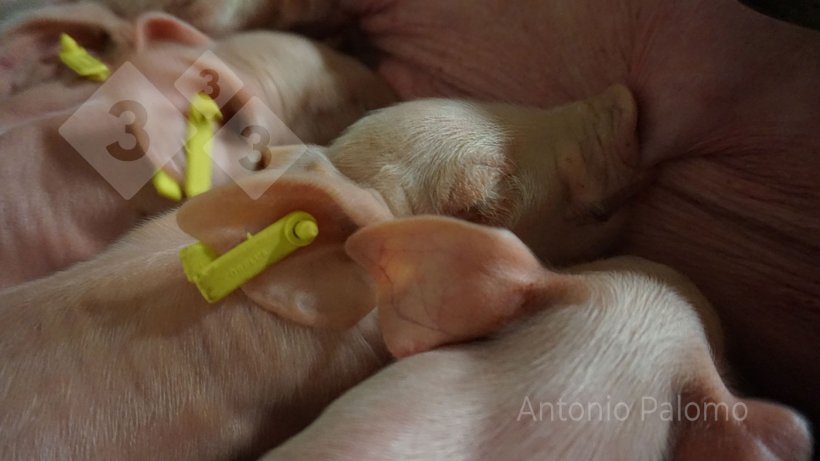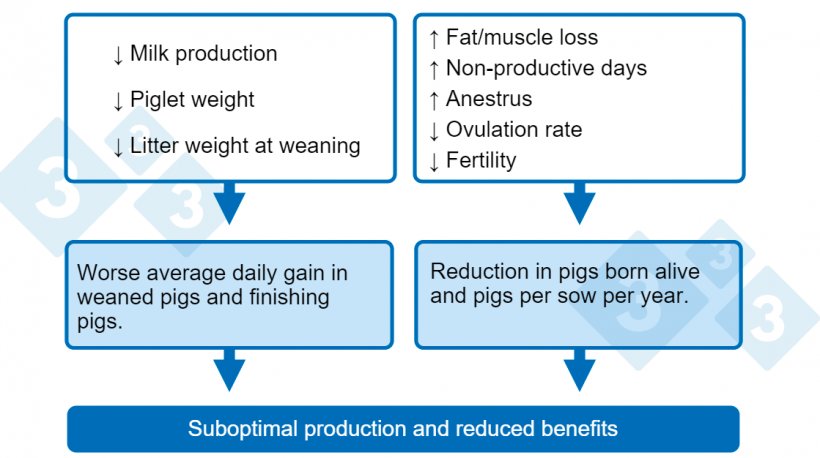The transition period (TP) is defined as the last ten days of gestation and the first ten days of lactation, a period in which important physiological and metabolic changes occur in sows.
In the TP, the increase in feed intake produces different results depending on the body condition of the sows at day 105 of gestation. In this period, it is important to differentiate the feeding curve between nulliparous-primiparous and multiparous sows, associated with live weight/body condition and environmental/seasonal conditions.

In general, a moderate increase in feed intake levels is appropriate for mammary development and colostrum and milk production and should be studied on a farm-by-farm basis. This results in higher colostrum production and higher lactose content (Decaluwe, 2014).

It has been postulated that proper nutrition in the TP will result in benefits throughout the lactation phase, where it is essential for the sow to ingest as many nutrients as possible, which correlates with her milk production and reduced loss in body weight. In 28-day lactations we can consider an intake above 200 kg/sow and in 24-day lactations >150 kg, but the most important thing is achieving the highest intake of daily digestible lysine (> 65 g) and daily net energy (> 14,500 kcal). The consequences of poor nutrient intake during lactation are quite varied as shown in the following chart:

Chart 1. Consequences of low nutrient intake during lactation.
Table 1: Critical points in achieving the highest nutrient intake during the lactation phase.
| Measure | Importance |
|---|---|
|
Prevent sows from arriving fat and/or overweight at farrowing, according to their parity number and genetics |
+++++ |
|
Thermalneutral environmental conditions, especially avoiding excessive temperatures (> 25ºC) |
+++++ |
|
Total availability of water in adequate quantity, quality, and temperature (> 25 liters sow/day) |
+++++ |
| Sows entering the farrowing room enough in advance (> 4-5 days) | +++ |
| Frequency of meals (4>3>2) | ++++ |
| Wet vs dry feeding | ++++ |
| Automatic feeding systems, ad libitum simulation | ++++ |
|
Diets with highly digestible protein and amino acids. Reducing crude protein levels in high temperature situations |
+++++ |
|
Diets with high energy content but with an adequate balance between fat and starch sources, with limitations on the percentage of added fats (3-3.5%) |
+++++ |
|
Limit crude fiber levels and provide a minimum of dietary fiber. |
++++ |
| Correct digestible calcium:phosphorus ratio | +++++ |
| Adequate electrolyte balance: 175-200 mEq/kg | ++++ |
|
Supply of vitamins and essential trace elements in organic form for feed consumption (A, E, B complex, Se, Fe, Zn, and Mn) |
++++ |
How are the different nutrients affected in the TP?

Energy: We know that almost 80% of the energy needs for maintenance at the end of gestation are lost as heat and only 20% goes to fetuses and tissues as maintenance energy, but we must remember that the needs are based on metabolic weight and we have sows with variations of up to 100 kg live weight. It is not clear whether the energy efficiency for colostrum production is the same as for milk production, nor whether it is the same for milk in the first 3 days, 10 days, or later.
Protein:
- More studies are needed to determine the amino acid and protein requirements in this transition period considering the repercussion on the protein metabolism of the uterine regression , theoretically higher in sows with more parities.
- The requirements for nitrogen maintenance in this period are also not well known. This may indicate that protein must be a limiting factor for sow productivity at the end of gestation, while lysine is a limiting factor after farrowing.
The inclusion of nucleotides around farrowing showed modulation of immunity by causing an increase in colostral IgG levels, in addition to greater homogeneity in piglet weight at weaning and a higher weight at eight weeks of age (Palomo, 2015).
Lipids:
- Supplementation with omega-3 fatty acids in the last month of gestation has also been shown to increase piglet vitality at birth (Rooke, 2001).
- The contribution of medium and long-chain fatty acids in different ratios has been the subject of numerous studies in regards to hepatic metabolism, varying the inclusion of animal lipids for others from different sources (coconut oil, sunflower oil, fish oil), observing a beneficial effect on the amount of colostrum produced, the individual consumption of colostrum by the piglets, and better growth in the first 24 hours of life.
- The fatty acid profile of the lipids we provide will determine the fatty acid profile of the colostrum, as both lipids and immunoglobulins have a sensitive response to sow nutrition.
- Supplementing raw materials that are rich in dietary fiber at the end of gestation makes it possible to increase the lipid content of colostrum (Loisel, 2013), by increasing the plasma concentration of short-chain fatty acids that are used by the mammary gland as precursors for lipid synthesis.
It is documented that supplementation with certain probiotics, prebiotics (mannanoligosaccharides) and conjugated linoleic acid (Wu, 2015) in the peripartum feed and/or last month of gestation) produces an increase in IgG in colostrum.
In addition to the energy, protein, amino acids, and fiber requirements, we consider it essential to take into account the requirements for minerals and vitamins, as well as specific additives in this transition period, since micronutrition in hyperprolific sows is one of the pillars for their productive efficiency and longevity.
As an example:
- Calcium: An appropriate calcium level will support the physiological process of farrowing. Excesses or insufficient calcium can cause impairment of this mechanism.
- Zinc: Its role in reducing stillborn piglets is well referenced, but the exact mechanisms that determine this are not known. Due to the legal limitations of this mineral in Europe, we believe it is opportune to incorporate it in its organic form to achieve its beneficial effect on the breeding sows connected to this point.
We can deduce that it may be more accurate to pay attention to the daily nutrient intake per sow according to the point in the reproductive cycle in this critical period, rather than just focusing on the amount of feed per sow per day.



